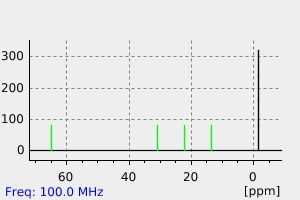1,1-二甲基-1-硅-2-噁环己烷 | 5833-47-6
中文名称
1,1-二甲基-1-硅-2-噁环己烷
中文别名
1,1,-二甲基-1,2-硅氧杂环己烷
英文名称
2,2-Dimethyl-1-oxa-2-silacyclohexan
英文别名
1-Oxa-2-silacyclohexane, 2,2-dimethyl-;2,2-dimethyloxasilinane
CAS
5833-47-6
化学式
C6H14OSi
mdl
MFCD00023112
分子量
130.262
InChiKey
CWUHERHJSPPFHQ-UHFFFAOYSA-N
BEILSTEIN
——
EINECS
——
-
物化性质
-
计算性质
-
ADMET
-
安全信息
-
SDS
-
制备方法与用途
-
上下游信息
-
文献信息
-
表征谱图
-
同类化合物
-
相关功能分类
-
相关结构分类
物化性质
-
熔点:<0°C
-
沸点:122 °C
-
密度:0.8820 g/cm3
-
闪点:14°C
计算性质
-
辛醇/水分配系数(LogP):1.86
-
重原子数:8
-
可旋转键数:0
-
环数:1.0
-
sp3杂化的碳原子比例:1.0
-
拓扑面积:9.2
-
氢给体数:0
-
氢受体数:1
安全信息
-
TSCA:No
-
危险类别码:R11
-
危险品运输编号:UN 1993
-
安全说明:S16,S26,S36,S9
SDS
反应信息
-
作为反应物:描述:1,1-二甲基-1-硅-2-噁环己烷 在 氢化钾 、 magnesium 作用下, 以 乙醚 为溶剂, 150.0 ℃ 、1.6 MPa 条件下, 反应 6.5h, 生成 phenyldimethyl<4-(vinyloxy)butyl>silane参考文献:名称:Volkova, L. M.; Zhdanov, A. A.; Mordvinova, L. A., Journal of general chemistry of the USSR, 1980, vol. 50, # 5, p. 858 - 861摘要:DOI:
-
作为产物:描述:(3-butenyloxy)trimethylsilane 在 dihydrogen hexachloroplatinate 、 二甲基一氯硅烷 作用下, 以 异丙醇 为溶剂, 生成 1,1-二甲基-1-硅-2-噁环己烷参考文献:名称:Kozlikov,V.L. et al., Journal of general chemistry of the USSR, 1969, vol. 39, p. 2226 - 2229摘要:DOI:
-
作为试剂:描述:烯丙基丙二酸二乙酯 在 RuCl2(1,3-dimesityl-imidazolidin-2-yl)(PCy3)(=CHPh) 1,1-二甲基-1-硅-2-噁环己烷 作用下, 以 甲醇 、 水 为溶剂, 反应 2.0h, 以67%的产率得到2,7-bis-ethoxycarbonyl-oct-4-enedioic acid diethyl ester参考文献:名称:Occlusion of Grubbs' Catalysts in Active Membranes of Polydimethylsiloxane: Catalysis in Water and New Functional Group Selectivities摘要:The Grubbs' first and second generation catalysts were occluded into cross-linked slabs of polydimethylsiloxane with volumes from 1 mm3 to 1 cm3 by swelling the polymer with catalyst and methylene chloride. Methylene chloride was evaporated under vacuum to yield occluded catalysts where their solvent was polydimethylsiloxane. These occluded catalysts were reacted with alkenes dissolved in H2O or H2O/MeOH mixtures that diffused into the polydimethylsiloxane to react by ring-closing metathesis and cross metathesis. Control experiments revealed that the catalysts remained occluded and metathesis did not occur in the solvent. Occlusion of these catalysts allowed commercially available Grubbs' catalysts to be used with H2O as the solvent while isolating the H2O sensitive ruthenium methylidene from exposure to H2O. Functional group selective experiments were carried out where the polydimethylsiloxane was an "active" membrane to exclude salts. Polydimethylsiloxane is a hydrophobic polymer, so the deprotonated salt of diallylmalonic acid did not diffuse into it while a diallylether diffused into it and reacted by metathesis. Thus, by controlling the polarity of reagents their reactivity can be controlled owing to the properties of polydimethylsiloxane rather than those of the Grubbs' catalysts. Occlusion of catalysts in polydimethylsiloxane has been shown to add new selectivities to mature catalysts.DOI:10.1021/ja0642212
文献信息
-
Regiochemistry of alkenylsilyl and alkenyldisilanyl radical cyclizations作者:Thomas J. Barton、Anthony RevisDOI:10.1021/ja00325a015日期:1984.6Les radicaux silyles produits par enlevement d'hydrogene a partir d'un butenylsilane, d'un allyldisilane, d'un pentenylsilane, d'un butenyldisilane et d'un butenyloxysilane se cyclisent tous de maniere endo, a l'oppose des radicaux carbones analogues
-
Palladium-catalyzed rearrangement of silanes containing oxygen or halogen α to silicon作者:Vladimir Gevorgyan、Larisa Borisova、Edmunds LukeviesDOI:10.1016/0022-328x(92)85060-a日期:1992.9Rearrangements of tetrahydrofuryl- and tetrahydropyranyl-hydrosilanes to oxasilaalkanes, of acetoxymethyl-hydrosilanes to acetoxysilanes, and halogenomethyl-hydrosilanes to halogenosilanes in the presence of palladium catalyst have been studied. The reaction has been shown to proceed more rapidly in tetrahydrofuran and hexane than in benzene or acetonitrile. The progressive replacement of the methyl
-
Preparing ester containing organosilicon compounds申请人:(SWC) Stauffer-Wacker Silicones Corporation公开号:US04647683A1公开(公告)日:1987-03-03An improved process for preparing ester containing organosilicon compounds by reacting chloro-organosilicon compounds with a carboxylic acid in the presence of a base and a promoting solvent, the improvement which comprises conducting the reaction in the presence of a halide salt.
-
Organosiloxane compound with one end stopped with an aminoalkyl group申请人:Shin-Etsu Chemical Co., Ltd.公开号:US04981988A1公开(公告)日:1991-01-01A novel organosiloxane compound of the formula ##STR1## wherein R is either hydrogen atom or an alkyl having 1-3 carbon atoms, and n is an integer such that 0.ltoreq.n.ltoreq.1,000, is effective in improving surface characteristics of synthetic silicon resins in which it is contained such as oxygen permeability and surface slip factor, and is produced by reacting a cyclic silazane of the formula ##STR2## with a silanol of the formula ##STR3##
-
Organosiloxane and process for preparing the same申请人:Chisso Corporation公开号:EP0338577A3公开(公告)日:1991-03-06The present invention relates to an organosiloxane compound suitable for the modification of silicone rubbers and synthetic resins, an organosiloxane compound useful as its intermediate, and a process for preparing them. The organosiloxane compound of the present invention can be represented by the general formula (IV) wherein j is an integer of 1 to 2000, R is an alkyl group having 1 to 4 carbon atoms, and R1 is a pentafluorophenyl group or a straight-chain or a branched fluoroalkyl group represented by the formula (II) wherein a is an integer of 3 to 18, and b is an integer of 0 to 2a.Furtheremore, the siloxane compound of the present invention may have one, two or three siloxane chains each having a substituent with a fluorine atom containing group at the terminal thereof. Each of molecules constituting the polysiloxane compound of the present invention has a terminal hydrosilyl group portion and a fluorine atom-containing terminal substituent portion therein. Since the reactive group of the hydrosilyl group is chemically bonded to the synthetic resins, the deterioration in characteristics with time can be hindered. The synthetic resins can be provided with the specific function of the fluoroalkyl group without impairing characteristics which the polysiloxane has.本发明涉及一种适用于改性硅橡胶和合成树脂的有机硅化合物,一种作为其中间体有用的有机硅化合物,以及制备它们的方法。本发明的有机硅化合物可以用通式(IV)表示,其中j为1至2000的整数,R为具有1至4个碳原子的烷基,R1为五氟苯基或由式(II)表示的直链或支链氟烷基,其中a为3至18的整数,b为0至2a的整数。此外,本发明的硅氧烷化合物可能具有一个、两个或三个硅氧烷链,每个链末端具有含有氟原子的基团的取代基。构成本发明的聚硅氧烷化合物的分子每个都具有端基氢基硅基部分和含有氟原子的末端取代基部分。由于氢基硅基的反应性基团与合成树脂化学键合,因此可以阻止随时间的推移而出现的特性劣化。合成树脂可以具有氟烷基的特定功能,而不损害聚硅氧烷具有的特性。
表征谱图
-
氢谱1HNMR
-
质谱MS
-
碳谱13CNMR
-
红外IR
-
拉曼Raman
-
峰位数据
-
峰位匹配
-
表征信息
同类化合物
(2-溴乙氧基)-特丁基二甲基硅烷
鲸蜡基聚二甲基硅氧烷
骨化醇杂质DCP
马沙骨化醇中间体
马来酸双(三甲硅烷)酯
顺式-二氯二(二甲基硒醚)铂(II)
顺-N-(1-(2-乙氧基乙基)-3-甲基-4-哌啶基)-N-苯基苯酰胺
降钙素杂质13
降冰片烯基乙基三甲氧基硅烷
降冰片烯基乙基-POSS
间-氨基苯基三甲氧基硅烷
镓,二(1,1-二甲基乙基)甲基-
镁,氯[[二甲基(1-甲基乙氧基)甲硅烷基]甲基]-
锑,二溴三丁基-
铷,[三(三甲基甲硅烷基)甲基]-
铂(0)-1,3-二乙烯-1,1,3,3-四甲基二硅氧烷
钾(4-{[二甲基(2-甲基-2-丙基)硅烷基]氧基}-1-丁炔-1-基)(三氟)硼酸酯(1-)
金刚烷基乙基三氯硅烷
酰氧基丙基双封头
达格列净杂质
辛醛,8-[[(1,1-二甲基乙基)二甲基甲硅烷基]氧代]-
辛甲基-1,4-二氧杂-2,3,5,6-四硅杂环己烷
辛基铵甲烷砷酸盐
辛基衍生化硅胶(C8)ZORBAX?LP100/40C8
辛基硅三醇
辛基甲基二乙氧基硅烷
辛基三甲氧基硅烷
辛基三氯硅烷
辛基(三苯基)硅烷
辛乙基三硅氧烷
路易氏剂-3
路易氏剂-2
路易士剂
试剂Cyanomethyl[3-(trimethoxysilyl)propyl]trithiocarbonate
试剂3-[Tris(trimethylsiloxy)silyl]propylvinylcarbamate
试剂3-(Trimethoxysilyl)propylvinylcarbamate
试剂2-(Trimethylsilyl)cyclopent-2-en-1-one
试剂11-Azidoundecyltriethoxysilane
西甲硅油杂质14
衣康酸二(三甲基硅基)酯
苯胺,4-[2-(三乙氧基甲硅烷基)乙基]-
苯磺酸,羟基-,盐,单钠聚合甲醛,1,3,5-三嗪-2,4,6-三胺和脲
苯甲醇,a-[(三苯代甲硅烷基)甲基]-
苯并磷杂硅杂英,5,10-二氢-10,10-二甲基-5-苯基-
苯基二甲基氯硅烷
苯基二甲基乙氧基硅
苯基二甲基(2'-甲氧基乙氧基)硅烷
苯基乙酰氧基三甲基硅烷
苯基三辛基硅烷
苯基三甲氧基硅烷







